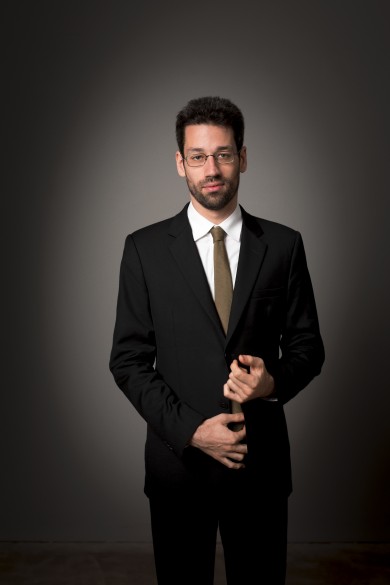Pianist Jonathan Biss brings out the Romantic extremes at Broward Center

Jonathan Biss performed Friday night at the Broward Center’s Amaturo Theater in Fort Lauderdale. Photo: Benjamin Ealovega
There was excitement and storytelling spanning the gamut of German Romanticism from Jonathan Biss Friday night at the Broward Center for the Performing Arts. The warm wooden interior of the smaller venue, the Amaturo Theater, was filled with a lively young crowd. At 34, the American pianist is youngish himself, but is a well-established performer and writer, with a following from his online course on the Beethoven piano sonatas.
Biss framed his program with this repertory, opening with Beethoven’s Sonata No. 1 in F minor. Although Classical in style, the work foreshadows Beethoven’s mature, bristly Romanticism, most clearly in the Allegro’s fragmented development and rising harmonic tension.
Musically, Biss is a risk-taker, underlining every note with substantial body language, always playing to the audience. Despite the hall’s muting acoustic, Biss’s onslaught of youthful abandon, rushed phrases and liberty with tempos freshened up the well-known Allegro in a good way, dangerously suggesting that the rest of the evening could run wild.
His mellow Adagio also pushed the tempi to the limit, but he settled into more conventionally proportioned phrases in the remaining movements. The pianist’s tempo was slow in the Menuetto, building the severe motive’s insistent rise and fall into a stormy crescendo. He pedaled running notes into blurry cascades for a contrastingly graceful Allegretto. His clear upper voicing over the tumultuous bass line in the Prestissimo was less rushed, unnecessary for the music’s already anxious energy.
In Beethoven’s Sonata in A major No. 28, Op. 101, the happily domestic themes featured Biss’ lulling interior lines, tastefully holding the tension in check until the development. His heroic Vivace nicely contrasted the pastoral Allegretto, not clean but exciting, and at times dreamy. Biss seamlessly connected the Adagio’s dark chorale into the finale’s flight of fancy through intelligent shaping of dissonances, phrases and form, and silences stretched nearly to breaking. By the concert’s end, Biss thankfully entered his own world where his physical gestures gave way to the music, and in the Allegro’s massive passagework, Biss’ true artistic voice emerged with no artifice, just passion.
In Robert Schumann’s Waldszenen, Op. 82, Biss focused on narrative, creating tableaus through self-contained moods. Many of the pieces are childlike, including the opening “Entry,” which Biss delivered capably, if not captivatingly. However, the more virtuosic works “Hunters on the Lookout” and “Friendly Landscape” were exciting, joyfully capturing the idyll. Outstanding were Biss’ evocative “Haunted Place,” driven forward with moody counterpoint and a sense of drama, and “Bird as Prophet” with its lonely songs nicely colored, with a pale, quiet ending.
Interspersed between the Schumann and Beethoven, Biss offered Arnold Schoenberg’s thorny masterpiece Six Little Piano Pieces, Op. 19, and Alban Berg’s only work for piano, the Sonata No. 1.
Schoenberg’s extremely brief miniatures are richly layered, but Biss interpreted them as line drawings rather than oil paintings. The three slow movements were best, especially in the gentle bell tones and soft pianissimos of the final piece, where Schoenberg’s harmonies emerged on equal footing with Biss’ primarily melodic interpretations.
In Berg’s Piano Sonata, small motives build into large-scale melodies in traditional Germanic style, but the harmonies underneath are full of color and uncertainty, a unique sound world. Biss nearly overwhelmed the defining melodic line with these chords, but his emphasis of emotion over clarity and rich colors over refinement had a powerful effect.
Posted in Performances
Leave a Comment
Sat Jan 17, 2015
at 11:40 am
No Comments